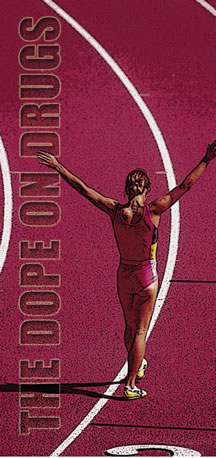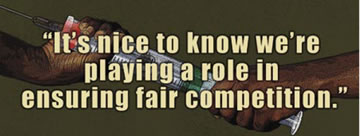
Vol. 14 No. 4 |
Spring 2005 |
 A
LOW-PROFILE
A
LOW-PROFILE
U OF U LABORATORY NABS HIGH-PROFILE CHEATERS
by Christopher Nelson
It’s not a player or a coach, but a laboratory.
Known as the Sports Medicine Research and Testing Laboratory (SMRTL), the facility can detect as little as one billionth of a gram of a prohibited performance-enhancing substance from an athlete’s blood or urine sample. It’s one of only two drug-testing facilities in the United States accredited by the World Anti-Doping Agency. (The other is at UCLA.) The lab also provides testing for the U.S. Olympic Committee (USOC).
“The samples we evaluate don’t come with names, so we don’t know which football player or Olympic athlete we’re screening,” says Dennis J. Crouch, who directs the lab and is a research assistant professor in the College of Pharmacy’s Center for Human Toxicology. “But it’s fun knowing our lab played a part in determining who is, and isn’t, taking the field on Sunday afternoon.”
The U was selected as the site for the laboratory in January 2004 by the United States Anti-Doping Agency, the NFL and the USOC. The reputation of the College of Pharmacy’s Center for Human Toxicology (of which SMTRL is part) and a $500,000 grant from the Salt Lake Olympic Committee were major factors in the decision to put the lab at the U.
“This laboratory is a legacy of our work during the 2002 Olympic Winter Games. Our experience with the Games has put the University in a position to become a leader in the fight against illegal doping in sports,” says John Mauger, dean of the College of Pharmacy. In addition to its contribution to the Winter Games, the College’s Center for Human Toxicology has played a role in a number of high profile cases, including drug testing of the captain and crew of the Exxon Valdez oil tanker that grounded in Alaska in 1989, spilling nearly 11 million gallons of oil into the biologically rich waters of Prince William Sound. The center is co-directed by Crouch and Diana G. Wilkins.
This summer, the SMRTL will move out of the space it currently shares with the Center for Human Toxicology into new facilities in Research Park. Crouch notes that the move will allow the lab to grow and begin greater collaboration with other sports medicine-related departments on campus. The new space will also provide greater security, which is required as part of its accreditation, and room for additional staff.
 Matthew
H. Slawson BS’90 PhD’97, the laboratory’s associate
director and a research assistant professor, is quick to point out that
many of the banned drugs the SMRTL tests for are not designer drugs and
are commercially available, often via the Internet.
Matthew
H. Slawson BS’90 PhD’97, the laboratory’s associate
director and a research assistant professor, is quick to point out that
many of the banned drugs the SMRTL tests for are not designer drugs and
are commercially available, often via the Internet.
“Many of these drugs are veterinary medications and animal steroids. In some cases athletes are taking legitimate therapeutic drugs like human growth hormone but are using them for performance-enhancing purposes,” he says.
“Workplace drug use is typically recreational and therefore fairly straightforward to detect,” says Crouch. “We know what the chemical compounds for drugs like marijuana, cocaine and heroin look like, and we have a high success rate in finding those drugs in blood and urine samples. People using performance-enhancing drugs, on the other hand, are much more creative. It’s more difficult to identify a banned substance that modifies the body’s own engineering.”
The testing process takes place behind tight security in the lab. Two blood or urine samples for each athlete are delivered via courier to the lab from around the country. One of the samples is stored for possible future testing, if, for example, an athlete appeals a test result.
The blood and urine are put through a series of chemical processes designed to extract certain drugs from the samples. Then, using one of the center’s 10 mass spectrometers and other sophisticated equipment, scientists can determine if a banned substance is present in the sample. Once the lab moves to its new location in Research Park, it will be able to screen up to 10,000 samples a year.
 Slawson
says the real detective work lies in interpreting the test results. “Some
of these banned substances are very good at integrating seamlessly into
the body’s own chemistry and mimicking an athlete’s natural
hormones. Our challenge is to determine whether the level of a naturally
occurring compound is at normal or excess levels,” he explains.
Slawson
says the real detective work lies in interpreting the test results. “Some
of these banned substances are very good at integrating seamlessly into
the body’s own chemistry and mimicking an athlete’s natural
hormones. Our challenge is to determine whether the level of a naturally
occurring compound is at normal or excess levels,” he explains.
That’s why it’s important for the lab to diligently conduct research into drugs that might be used in the future, according to Crouch. In essence, the lab wants to stay ahead of its competition and serve as a deterrent to underground sports medicine laboratories, as well as unethical trainers and athletes.
However, Slawson admits that it’s not possible to stay ahead of everyone but says it’s only a matter of time before the lab catches up with offenders.
“One of the things working on our behalf is that we test many of the same athletes over a long period of time. Therefore, we can watch for unexplained changes and hopefully draw conclusions about what’s going on from the data we collect,” he says.
A good example of this type of investigative work is the identification of the now-banned drug THG (tetrahydrogestrinone) by the drug-testing laboratory at UCLA. According to Slawson, the lab noticed that over time there were changes in the test results of a number of track and field athletes. At the time, testers couldn’t definitively identify what was going on. The coach of one of the athletes later found a syringe that contained what came to be known as THG. Once the compound was identified, the lab was able to go back and determine when the athletes started using the substance. Other sports later had retroactive testing conducted, and three NFL players were among those who tested positive.
Crouch stresses that not every high level athlete is trying to cheat. For example, statistics show that less than two percent of Olympic athletes ever test positive for a banned substance. “Unfortunately, those are the athletes that make this lab necessary,” says Crouch. “It’s nice to know we’re playing a role in ensuring fair competition.”
—Christopher Nelson BS’96 is associate director of the
Office of Public Affairs at the University of Utah Health Sciences
TO DOPE OR NOT TO DOPE? THAT IS THE ETHICAL QUESTION
 Imagine
you’re an Olympic swimmer. You’ve trained your entire life
to compete in an event in which the difference between a gold or silver
medal is decided by a fraction of a second. In the blink of an eye, you
will also win—or lose—millions of dollars in endorsements
and speaking fees.
Imagine
you’re an Olympic swimmer. You’ve trained your entire life
to compete in an event in which the difference between a gold or silver
medal is decided by a fraction of a second. In the blink of an eye, you
will also win—or lose—millions of dollars in endorsements
and speaking fees.
So, what if a trainer offers you an undetectable performance-enhancing drug that could give your body the edge it needs to reach the wall 1/100th of a second sooner than your competitor? Would you take it?
It’s a scenario that athletes face on a daily basis, according to Keith Henschen, professor of exercise and sports science in the University of Utah’s College of Health. And, he says, it’s not just at the Olympic level.
From professional leagues like the NFL and the National Basketball Association (NBA) to college teams, all the way down to the high school level, more and more athletes are tempted to use performance-enhancing drugs. The National Coalition for the Advancement of Drug-Free Athletics estimates that one in 30 student athletes currently uses performance-enhancing drugs, not including nutritional supplements.
Henschen, who serves as a sports psychology consultant to players in the NBA and the United States Track and Field team, believes there are two types of athletes using performance-enhancing drugs. The first group gets into doping because they feel that “everybody else is doing it.” The second group consists of athletes at the end of their careers who are trying to hold on, or recapture past glory.
At the core of the issue is a cultural conflict of values, according to Henschen. “We have an ideal that all athletic competitions should be fair. At the same time, mastering a sport has become financially lucrative. Athletics has become synonymous with money.
“I think society is sending mixed messages. Look at cases like Enron and WorldCom. Cheating is all around us. Our value system seems to be saying that it’s all right to cheat, unless you get caught.”
Still, Henschen’s personal experience gives him hope for the
future. “I’m enthused by the young athletes I work with who
don’t want to use these types of drugs,” he says. “But
what will happen in 10 years when their careers are winding down?
It’s hard to predict.”